Not sure how to get started in Manor Lords? It’s a common complaint. I’m of the opinion that solo developer Slavic Magic has made a rather special city-builder with Manor Lords, but it has to be said that the game can be pretty obtuse and confusing at times.
If you’re itching to build your own town in Manor Lords but you’re not sure where to begin or whether you’re doing things right, that’s where we hope to help you. In this beginner’s guide, I will walk you through your first year in Manor Lords, handling everything from the initial few buildings and family assignments to big projects like food production, building your first Church and Manor, and surviving your first Winter. At the end, I’ll also leave you with some key objectives for you to prepare for in Year 2.
So! Here’s how to get off to a roaring start in Manor Lords!
Note: for this walkthrough, I’ll assume that you’ve chosen the default starting scenario: “Restoring The Peace”. But no matter which scenario you choose, this guide should help you through the basics of setting up your town.
1. Pause the game, and construct these buildings
When you first load into the world, immediately pause the game and take a look around your region of the map. You should see a few key resources: Berries and Wild Animals will be the most important, as they’re your early-game food sources. There may also be Stone, Iron, and Clay, which you won’t have to worry about for a while, but it’s good to note their whereabouts ahead of time.
With the game still paused, open up the build menu and construct the following buildings with your starting supplies:
- Logging Camp
- Storehouse
- Granary
- Well
- Marketplace
- (Optional) Woodcutter’s Lodge
It’s important to build the Logging Camp first, to get some early Timber production going as soon as possible.
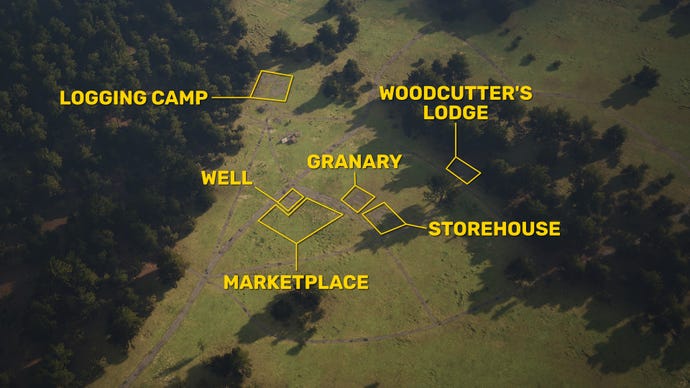
All of the buildings except the Logging Camp and Woodcutter’s Lodge should be near the centre of where you’d like your village to be. The Logging Camp should be placed near a forest, but make sure it isn’t too close to any Wild Animals. I personally like to place down a Woodcutter’s Lodge early on as well so it’s ready when I need it, but it’s not necessary. If you do place one now, you should ideally place it near a different patch of trees to your Logging Camp.
2. Build a basic road network between key areas
With the game still paused, start hashing out a basic road network. Roads in Manor Lords are completely free and instantly built, so it’s always a good idea to build them at the start of the game while paused.
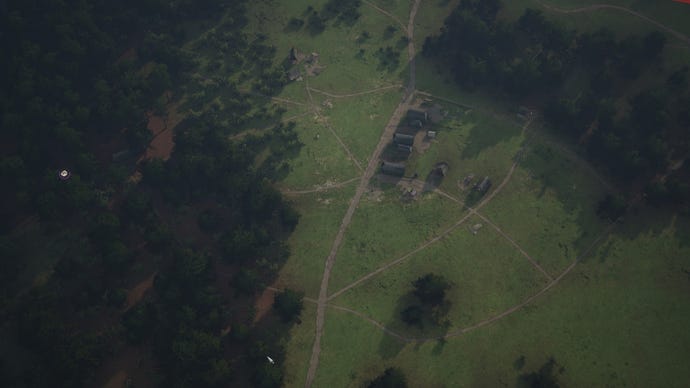
The general idea with these starting roads is to connect all your starting buildings to each other, while also leaving large-ish gaps for Burgage Plots and other buildings later on. It’s particularly important to make sure your Population (and Oxen) have road access from the Logging Camp to the rest of your village, because the Logging Camp is where you store all the Timber you need for constructing new buildings.
I’d also recommend placing down some longer roads from the centre of your village towards the nearest Berries and Wild Animals. We’ll revisit them in Step 4.
3. Assigning your families to work
It’s time to unpause the game and let your villagers build those starting buildings you placed down. Feel free to speed up the game or slow it down with the buttons in the bottom-right (hotkeys: Z and X).
Once your Logging Camp is built, click on it and assign 2 families to it immediately. They’ll start chopping wood for more Timber, and meanwhile your other 3 families will continue building.
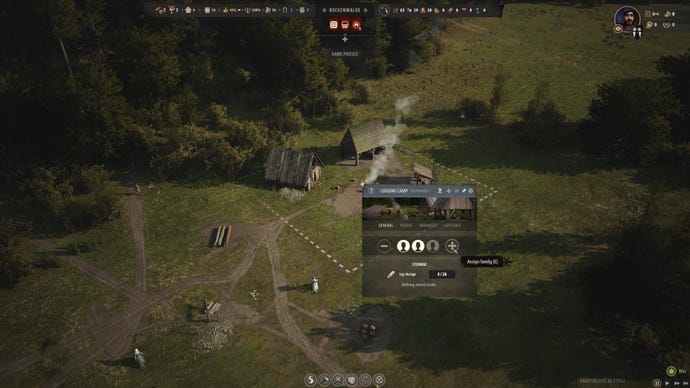
Once your Storehouse and Granary are built, assign 1 family each to them, to start storing resources so they don’t get ruined when it starts to rain. Your one remaining family can deal with the rest of the building for now, but if need be you can take one extra family off the Logging Camp to help out.
The extra benefit of assigning families to work in the Storehouse and Granary is that you’ll quickly get Food and Firewood Stalls set up in your Marketplace. You’ll need these Stalls to keep your people happy after setting them up in Burgage Plots in Step 5.
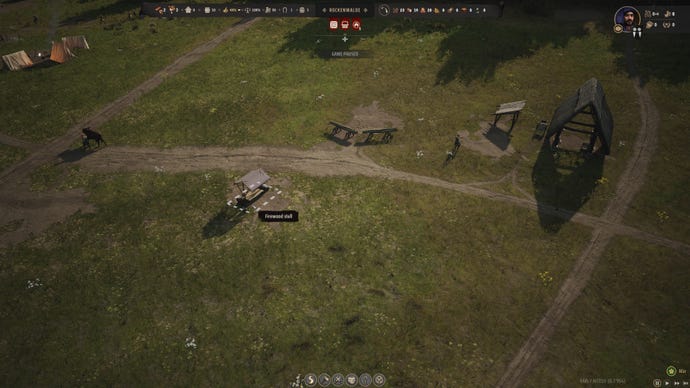
4. Set up food production
Now it’s time to set up food production. At the moment, your families are living off the supplies of bread they brought with them, but that will soon run out.
The type of food production you set up first really depends on which food source is closer to your village: the Berries, or the Wild Animals. In my playthrough the berries were nearby, so I set up a Forager Hut in the wood right next to the Berry bushes.
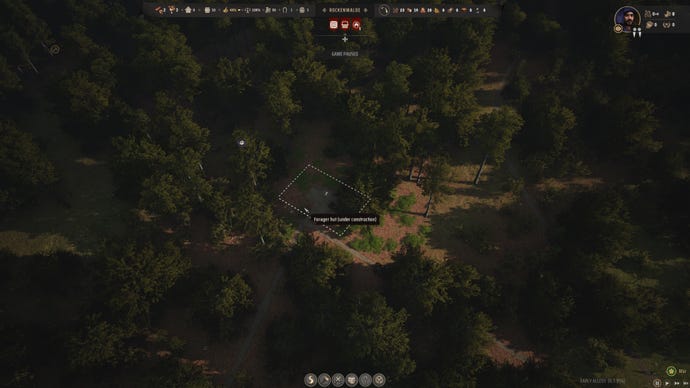
But if Wild Animals are in a better spot for you, then I’d recommend building a Hunting Camp near them instead. You don’t need both food sources immediately, so just pick whichever is more convenient.
Once your chosen building (Forager Hut or Hunting Camp) is built, set a family working there, but make sure you still have one family free for building. To recap: your families should now have the following work:
- Logging Camp (1 family)
- Storehouse (1 family)
- Granary (1 family)
- Food building (1 family)
- 1 family unassigned and free for building jobs
5. Build your first Burgage Plots
All this time, your families have been living in their starting tents, and you may have noticed your Approval Rating starting to decline next to the thumbs up arrow at the top of your screen. The solution is to start building Burgage Plots, which are where your families live in Manor Lords.

We’d highly recommend you build your first 3 or so Burgage Plots so that they have extra Living Space Extensions (depicted by the icon of the house with the plus sign). As you’ll know if you’ve read our Manor Lords tips and tricks guide, Living Space Extensions allow you to expand your population more easily, with less overall cost to your Burgage Plots.
Plop down 3 Burgage Plots for now, and let your builders work on them for a while.
6. Get another Ox and Hitching Post

One thing that really slows down a lot of new players in the early game is that they rely heavily on their one starting Ox to ferry all that Timber to and fro. But you can easily double that workrate by ordering another Ox! To do this, just click on your Htiching Post (which you begin the game with), and click the “Order Another Ox” button. It costs 20x Regional Wealth out of your total 50, but it’s a worthwhile investment.
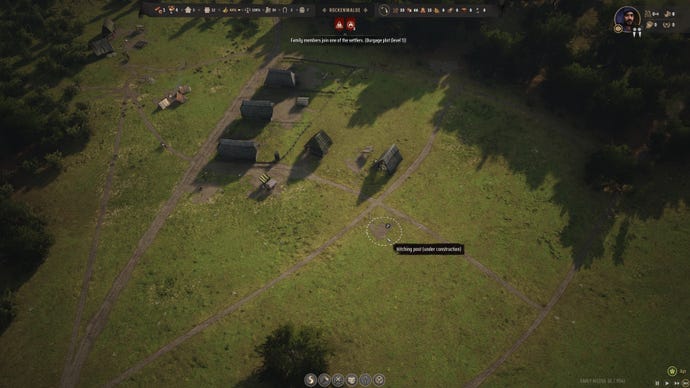
However, you also need to build another Hitching Post, because each Hitching Post can only handle one Ox. It’s a good idea to build multiple Hitching Posts anyway, so that your Oxen are spread across your settlement and can do transport jobs more quickly. I placed mine pretty much in the centre of my town, and I suggest you do something similar.
7. Time to eliminate homelessness
You should now have 3 Burgage Plots set up, but that still means 2 out of your 5 families are stuck in your starting tents. You can build more Burgage Plots (and indeed, that’s the next step), but it’s even quicker to make use of those Living Space Extensions you built into your first Plots.
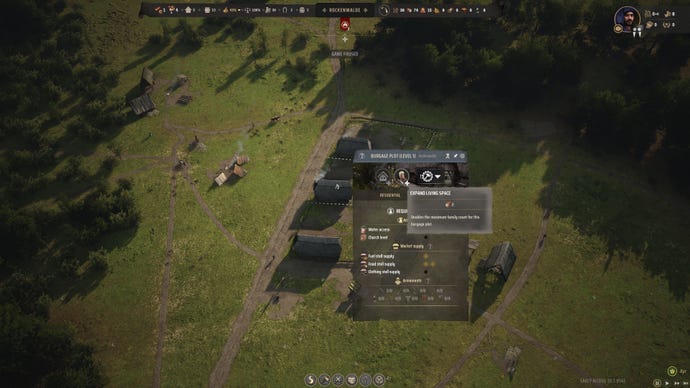
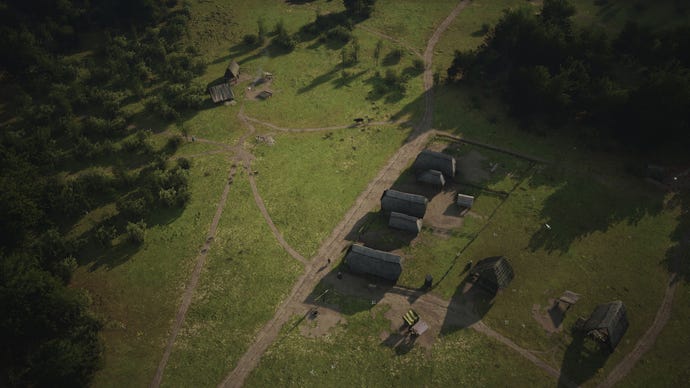
Once those extensions are built, you should see your starting tents disappear, as no one is living in them anymore. No more homelessness! Huzzah!
8. Expand your village with more Plots and Roads
Your overall goal is to expand your town and take over the map, but your smaller goals should really be dictated by your settlement levels. Hover over your settlement name at the top of the screen and you’ll see the requirements needed to upgrade to the next settlement level. In our case, we need 5 Burgage Plots, so let’s build the other two now.

Remember to keep your Burgage Plots fairly close to your Well and Marketplace as they’re important for your Approval Rating; and it’s also a good idea to keep them close-ish to the Storehouse, Granary, and Logging Camp.
I also took this opportunity to flesh out my settlement’s road system a bit more. Now that the starting supply areas and tents were gone, I could afford to be a little neater and more efficient with road placement.

9. Your first Development Point
The moment your fifth Burgage Plot is built, you’ll enter a new settlement level: the Small Village. And you’ll get a shiny new Development Point, to pop wherever you like in the Development Upgrades tech tree. Open up the tree by clicking on the settlement name at the top of the screen.
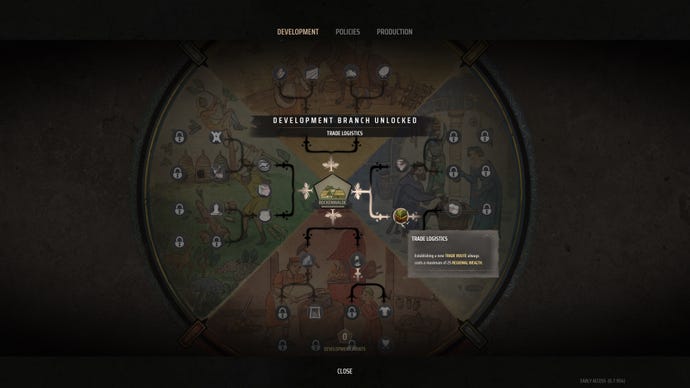
We’d recommend you put your first Development Point into Trade Logistics. It’s a fantastic early-game tech which will make setting up trade routes much, much less expensive. We’ll be starting up our Trade network very soon in Step 11, so it’s a good time to get Trade Logistics.
10. Assign your first new families to work
Now that you’ve eliminated homelessness, your Approval Rating should start creeping up above 50%. As long as it’s above 50% and you have empty Burgage Plots, you will periodically get new families joining your village. Which is great, because at the moment we’re basically using all our families already.

Whenever your next few families arrive, you should assign them to build a second food production building for whichever food source you haven’t already got (Berries or Wild Animals), and start a family working there the moment it’s built.
Your next family to arrive at the settlement should go towards building a Sawpit near your Logging Camp and working there to start making Planks. And your next family after that can start working in the Woodcutter’s Lodge for Firewood production.
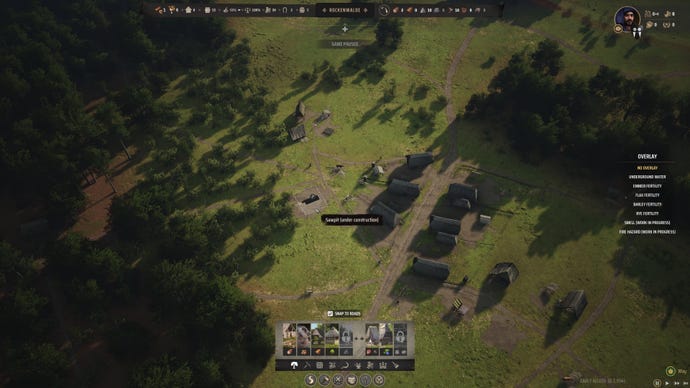
If you need more Burgage Plots before these families arrive, then go ahead and build them (and it wouldn’t hurt to have a couple of them with Backyard Extension space as well).
11. Build your first Trading Post
It’s time to build your first Trading Post. Traders come from off the edge of the map; there are little icons off the map edge to tell you where they spawn. Try to build your Trading Post fairly close to the edge of the map, connected to the main road.
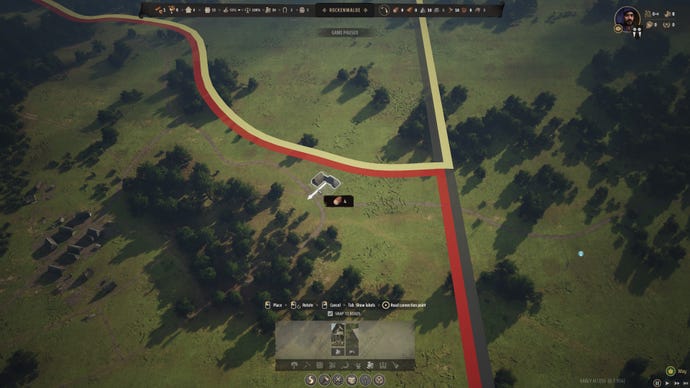
Trade is very important in Manor Lords. It’s the easiest and earliest way to get lots of Regional Wealth, which you’ll need for expanding and upgrading your town. Once it’s built, have a look at all your resources in the Trade tab to see if you have any large surpluses of resources.
In my case, I had an awful lot of Berries – enough to feed my village for 35 months, which is rather more than I need. So I started selling my Berries until I was down to just 100 of them, which is still more than enough for the time being.

A brief word on Bandits
This isn’t really a step, but at around this point of your playthrough, you may see your first Bandit Camps arise elsewhere on the map. These bandits may periodically steal some resources from your village. There’s nothing you can do about this until you start building up an army and taking them out, which we’d recommend you wait until Year 2 to do. So it’s not a big issue for now, it’s just something to keep in mind going forward!
12. Goats, Hides, and Leather
It may be a strange time to think of Clothing in the summer months, but winter will be on us soon. I recommend taking this time to start producing Leather, so that when winter arrives you’ll be able to start making Shoes.

You’ll have started getting a few Hides from your Hunting Lodge, but it’s good to get more, and closer to home. Take a couple of Burgage Plots with Backyard Extension Slots, and build some Goat Sheds there (or just one if you don’t yet have the Regional Wealth for it). These will provide a steady supply of Hides for your village.
Meanwhile, construct a Tannery nearby in the centre of town, and assign a family there once it’s built so you can start converting those Hides into Leather.
13. Keep an eye on your Firewood!
It was around this time that I realised my Firewood reserves were dangerously low, so consider this your warning to get a family working in the Woodcutter’s Lodge so that you have a nice healthy stockpile before Winter! Firewood is consumed twice as fast in Winter, so you’ll need a good amount.
14. Even more Burgage Plots

It’s time to build even more Burgage Plots! You need 10 Burgage Plots in total to reach the next settlement level, so I’d recommend building the remaining ones now. Living Space Extensions are always welcome as usual, but even more important at this point is to have some Backyard Extension slots ready for when you need to start creating weapons, Ale, and other more exciting resources.
Once again, keep your Burgage Plots fairly tight around the centre of your village, where your Well and Marketplace Stalls reside.
15. Planning ahead for major builds
It’s time to do a little bit of earmarking of space inside your village for some key buildings. Those buildings are: the Church, for religion; and the Tavern, for a different kind of religion altogether. The Church in particular is quite large, about the equivalent of a couple of decently-sized Burgage Plots. And it has to be fairly close to your Burgage Plots, so try and find a good spot for it.
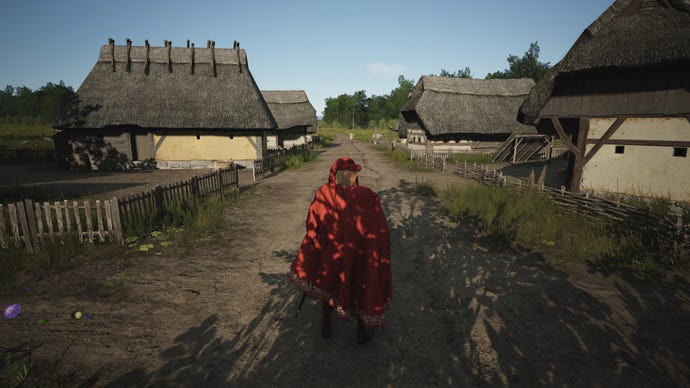
It’s also a good idea to earmark one of your Burgage Plots that has a Backyard Extension slot, preferably as near as possible to where your Tavern will go. This Burgage Plot can become your Brewery later on!
16. Lay a couple of Chicken Coops
I like to do what I can to diversify food types in the first year. So to that end, if you’ve got a couple of spare Burgage Plot Backyard Extensions handy, I’d recommend building a couple of Chicken Coops for 25x Regional Wealth each.
These Chicken Coops provide a slow but endless passive supply of Eggs, which will increase the total food offerings available to your Population. Not only does this increase their happiness, but the varied diet also makes your villagers less susceptible to illness.
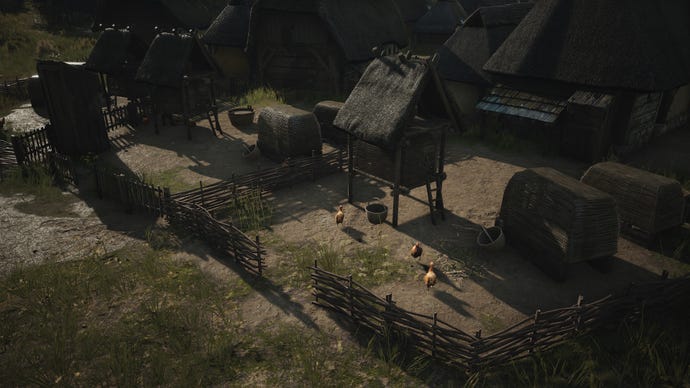
Remember: if you need more Regional Wealth, go to your Trading Post and sell off any big surpluses of major resources!
17. And along came religion
With all that work your Sawpit has been doing, you should now have at least 20x Planks (and probably a lot more to be honest). So now is a good time to build your first Church.
The Church is a hefty building, costing those 20x Planks I mentioned, plus 5x Timber and 10x Stone. You won’t have Stone production set up yet, but you should have enough Stone in your starting supplies to get the Church built.
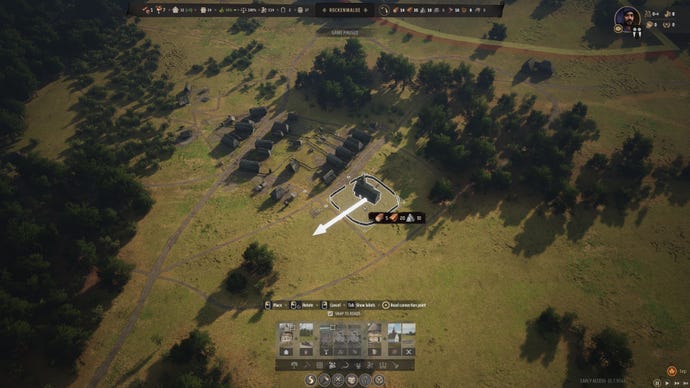
Once it’s built, you can set a Family working inside it if you like, but it’s not a requirement. It’ll just give you a little extra Approval Rating boost.
18. Expand your storage
My other recommendation at this Autumnal stage of your first year is to look at expanding your storage, to avoid any annoying “Generic Storage Full” prompts from the game. A Large Storehouse will hold 2,500 items instead of the regular Storehouse’s 250, and it doesn’t cost much at all.
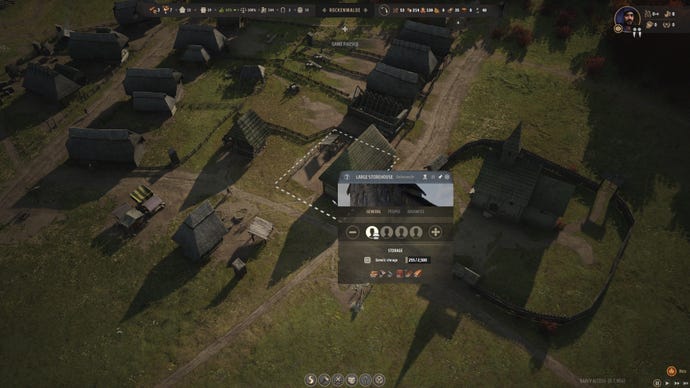
Just be sure to build it while it isn’t raining, because the moment you begin the upgrade, the entire contents of the Storehouse will be dumped on the ground.
19. Upgrade your first Burgage Plots
We’re getting towards the end of the first year’s major objective: reaching the Medium Village milestone. You should already have at least 10 Burgage Plots in your settlement, so all that remains to hit the settlement level goal is to upgrade at least two Burgage Plots to Level 2.
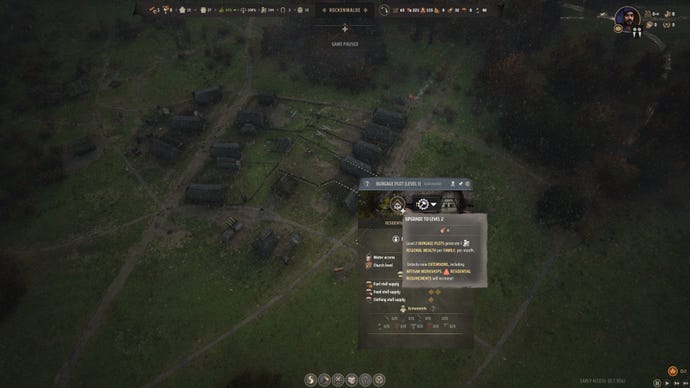
Upgrading only costs 4x Timber. You can only do it once all of the approval requirements in that Burgage Plot are satisfied, but that shouldn’t be an issue if you’ve been following along with this walkthrough! Get those upgrades done, and I’ll see you in the Medium Village era.
20. Your second Development Point
Congratulations! You are now the proud owner of one Medium Village. Your reward? A new Development Point. And I know just where it should go.
So, open up the Development tech tree again by clicking on the village name at the top, and this time select Better Deals, which is the Development Upgrade just on from the Trade Logistics tech you unlocked last time.
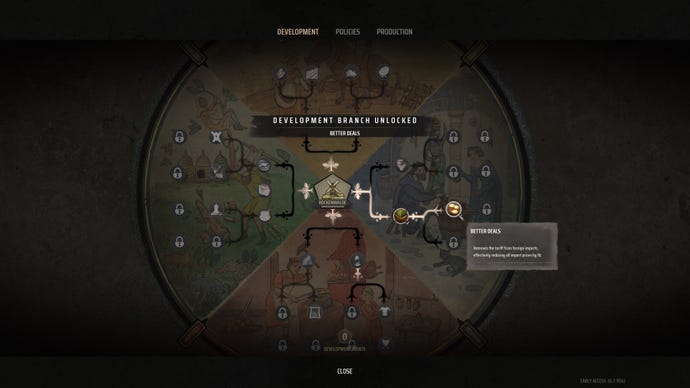
Better Deals is probably the single most powerful Development Upgrade in Manor Lords right now. It removes the 10x Regional Wealth tariff on all your imports at the Trading Post, which in simple terms means everything can be bought for 10x Regional Wealth cheaper. That’s a huge deal when you’re looking at more expensive items like Polearms and other weapons that you’ll need for raising your first army later on.
21. Start collecting Stone for your Manor
As Winter dawns, there’s just a couple more jobs that I’d recommend squeezing into Year 1 if you can. The first is to construct your Manor, which in some ways (mainly thematic ways) is the most important building in your whole settlement.
Once you construct your Manor, you’ll be able to start taxing your Population for Treasury and Influence, and you can also start hiring Retinue to help you in battle.
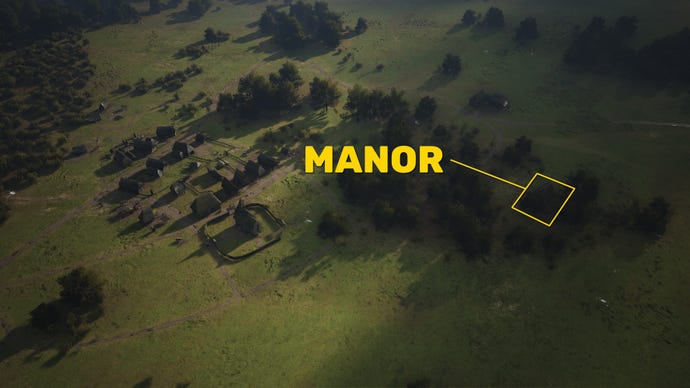
The only issue is that your Manor requires Stone to build, and you probably won’t have enough. You could always purchase the Stone at the Trading Post, but there’s no reason why you can’t start collecting Stone for yourself. Find the nearest Stone patch, build a road out to it, and construct a Stonecutter Camp there. Then set one of your families working in the Stonecutter Camp, and they’ll periodically ferry the Stone back to your base. Soon you’ll have more than enough to build your first Manor.
When the time comes to actually place down your Manor, you’ll enter the Castle Planning screen where you can expand walls, add towers and outposts, and more. But all of that stuff is very costly in materials and time-consuming to build, so we’d recommend just building the basic Manor for now. Once it’s built, you can re-enter the Castle Planning screen at any time to add more walls and gubbins.
22. Start making Shoes from your Leather
Remember all that Leather you’ve been making? Well, your Level 1 citizens may have been happy draping Leather over themselves, but Level 2 citizens want actual Clothes. There are three types of Clothing items in Manor Lords: Clothes, Cloaks, and Shoes. Clothes and Cloaks require Linen and Yarn, neither of which you have yet. So that leaves Shoes, which you can thankfully make out of Leather.

To start building Shoes, all you need to do is select one of your Level 2 Burgage Plots with a Backyard Extension Slot (if you don’t have one, build it!), and create a Cobbler’s Workshop. The Workshop costs 5x Regional Wealth and 5x Planks to make, which shouldn’t exactly break the bank. The downside is that you’re effectively locking that family away from any other jobs throughout the village, but that’s okay. You can always get more families.
Once the Cobbler’s Workshop is done, you should begin to see Leather being slowly turned into Shoes and stored in your Large Storehouse (or sold at a Clothing stall). That’s one of the major hurdles for upgrading to Level 3 Burgage Plots already complete!
23. Surviving Winter
By this point in my game, Winter had arrived, and draped my burgeoning settlement in a lovely blanket of white snow. Thankfully, if you’ve followed along with this guide, there’s really nothing to worry about over the Winter period. Your people should have plenty of food (of varying varieties) and lots of Firewood. If need be, you can always set two families working in your Woodcutter’s Lodge at once, for extra Firewood – but it shouldn’t be necessary.
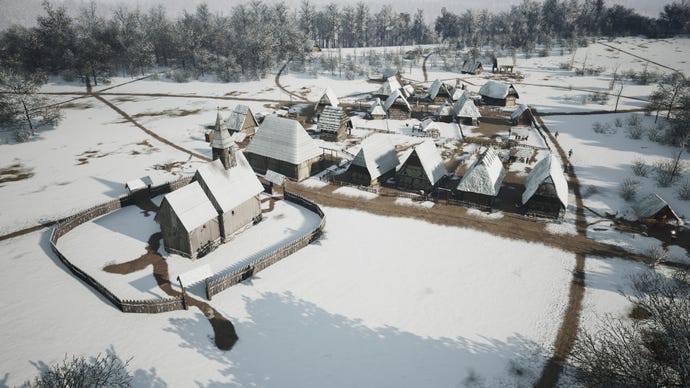
You don’t need to take any special precautions during Winter. This isn’t Frostpunk; your people can take care of themselves as long as they have food, fuel, clothes, and a little bit of religion to help them get through the long nights. And that’s just about the entire first year of Manor Lords sorted! Congratulations on surviving and thriving!
24. Year 2 objectives…
I’ll leave you with a few key objectives to think about for Year 2 of your Manor Lords playthrough:
- Farming: You should start putting down a Farm or two. One for Wheat (Emmer) and one for Barley (for your Ale). For details, check out our Manor Lords Farming guide.
- Rooftiles: To upgrade your Burgage Plots to Level 3, you need to upgrade your Wooden Church to a Stone Church. Apart from all the Stone you’ll obviously need, the upgrade also costs Rooftiles, which are made from Clay. So you’d better build a Mining Pit over your nearest Clay source…
- Bandits: It’s time to start thinking about raising an army and marching them across the map to deal with those Bandits that keep stealing your goods. Bandits are weak in battle, but I’d recommend having an army of at least 20 to take on the standard band of 16 Bandits.
- Ale Production: What’s life without Ale? You need a Tavern to keep your people happy. And for the Tavern to work, you need Ale. And to make Ale, you need Malt. And to make Malt, you need Barley. It’s a fairly long process, so you’d best start early on in your second year.
- Iron Production: Iron is the other key resource you haven’t tapped yet. Iron Ore from your Mine can be refined into Slabs, which can be formed into Tools, weapons, and armor. You won’t be able to handle the incoming Raiders without it.
- Expanding your Town: Aside from everything else, don’t forget to keep expanding your settlement. Build more Burgage Plots whenever you start to fill them up. And when the time comes, you can look at claiming your second territory and starting from scratch there with a new neighbouring settlement.
I’ll let you figure out the details of these Year 2 objectives for yourself, but you should be on very firm footing after such a successful first year. Hopefully you found this beginner’s guide useful, and good luck Manor Lording!


